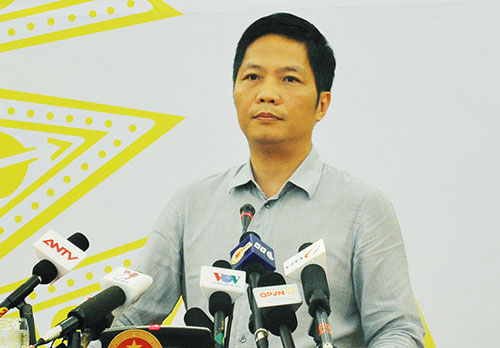MoIT gives overview of 2017 plan
 |
| Tran Tuan Anh |
Could you share with us the measures through which the Ministry of Industry and Trade will deal with the 12 loss-making projects under discussion?
It is clearly that the government has concrete steps, as it established a steering committee to resolve the shortcomings and weaknesses of the 12 projects at issue, which are under the supervision of the Ministry of Industry and Trade (MoIT). All the requirements and rules are clarified in this decision.
This committee is responsible for directing our ministry, relevant business groups, corporations, and units to fulfil the specific requirements and carry out the solutions set out by the prime minister to address the issue. It will assess the production capacity of the domestic enterprises, and the import and sale of products related to each project in order to propose specific solutions for them.
In addition, the committee will study and apply the rules in the trade agreements that Vietnam has signed to best protect the domestic market – these are also in line with international commitments. It is also in charge of controlling and reducing production costs, and negotiating with partners on investment co-operation or project transfer.
The steering committee shall request ministries, relevant groups, and corporations make comprehensive evaluations of the projects in question, from the policy to the implementation and the operation of these projects. The technology and equipment utilised and the quality of management staff and contractors should be strictly examined.
Projects that have production capability will be restructured in terms of production, human resources, and management. Those that cannot be restructured will be auctioned, divested, dissolved, or declared bankrupt according to law. In addition, the committee will help to clarify the responsibility of the unit and person in charge of these projects' implementation.
From these two approaches, we will continue to review the policies which resulted in these situations, and not allow the same situations to happen again.
Can you address equitisation progress for state-run firms under MoIT?
This is under the government’s direction, as it plays a key role in economic restructuring strategy. And progress on this issue has already been carried out.
During the current administration, MoIT has actively implemented and issued numerous documents guiding the equitisation of economic groups, corporations, and companies. In particular, the ministry has asked units to urgently implement governmental resolutions and directions and ministry and management agency guidance documents. This is especially the case with the prime ministerial direction to implement the restructuring of state-owned enterprises.
MoIT is co-operating with various ministries and departments to efficiently overcome difficulties in the equitisation process, such as selecting strategic partners and implementing equitisation based on the provisions. However, it is not only the progress of equitisation against the set timeframe that we are concerned about, but also the quality of equitisation.
Of the work ahead for 2017, what will MoIT prioritise?
All of the work is a priority. But the first thing on the schedule is the effort to reform and improve administrative procedures and strengthen institutions. The business environment must enable all economic sectors with equal access to markets, exploiting the country's resources to serve economic development and society.
Second, in context of deeper integration, we have to use tools and advantages effectively that integration brings in order to access foreign markets. Besides for improving competitiveness, protecting the domestic production system and preparing it for international integration is very necessary.
The third is the innovation of the growth model; it needs to focus on quality. That is, technology content and labour productivity are factors which must play an essential role in the value of products. There must be a connection between state agencies in facilitating technology adoption to encourage enterprises to improve labour productivity.
The fourth is to continue to arrange and innovate state-owned enterprises. This initiative must be accompanied by institutional oversight, to ensure efficient administration and avoid corruption.
| RELATED CONTENTS: | |
| Steel plan drops 12 projects | |
| MoIT looking for consultancy company for long-delayed steel plant | |
| MoIT grilled over ailing SOEs | |
| MoIT abolishes 471 hydro-electricity projects | |
What the stars mean:
★ Poor ★ ★ Promising ★★★ Good ★★★★ Very good ★★★★★ Exceptional
Latest News
More News
- UOB sees Vietnam growth easing in fourth quarter (December 22, 2025 | 17:39)
- Government moves to establish International Financial Centre (December 21, 2025 | 21:00)
- Vietnam's IFC to target global investment flows (December 21, 2025 | 18:00)
- Ha Tinh breaks ground on major Vingroup industrial and energy projects (December 19, 2025 | 18:24)
- EVN launches major power infrastructure projects nationwide (December 19, 2025 | 18:17)
- VAL inaugurates second production line to meet domestic animal feed demand (December 19, 2025 | 16:37)
- Sun Group pioneers urban tram system in Phu Quoc (December 19, 2025 | 15:00)
- Top 10 notable events of Vietnam’s industry and trade sector in 2025 (December 19, 2025 | 14:00)
- Seven major projects launched to drive Hanoi’s next growth phase (December 19, 2025 | 14:00)
- Rare, beautiful, sustainable: the mark of iconic real estate (December 19, 2025 | 08:00)

















 Mobile Version
Mobile Version